Ecology of Gib Hill
The Gib Hill Nature Reserve consists of a group of small, hedge-lined fields, once a common feature of the small-scale agricultural system of times gone by in Lancashire, but now almost extinct. They represent a kind of ecological time-capsule, escaping the push to larger fields and intensive agricultural practices of high fertiliser use, pesticide application, mechanisation, drainage, and re-seeding since the 1960s.
Most of Gib Hill LNR meadow and pasture fields are unimproved neutral grasslands. These grasslands occur on soils that are neither strongly acidic nor lime rich. Traditionally they were managed for hay cropping or simply grazed as permanent pasture and have a rich mix of native grasses and flowering plants. In Britain, they are now confined to small, fragmented localities in the lowlands and fringes of upland areas, where they provide important habitats for a variety of wildlife, including insects, small mammals and birds.
The importance of wildlife-rich old meadows and pastures is recognised by their inclusion in the list of priority habitats in the UK Government’s Biodiversity Action Plan 1998 which set out a range of targets and actions to help conserve and expand grassland habitats for future generations. Then later, they became known as Habitats of Principal Importance and are identified for their biodiversity value, in Section 41 of the Natural Environment and Rural Communities Act 2006, so as to protect, restore and enhance their inherent biodiversity. The Environment Act 2021 sets out further targets and measures to halt the decline in nature by 2030 and develop a Nature Recovery Network.
Gib Hill fields are between 155 – 200 metres above sea level and occur between the altitudinal range of the National Vegetation Classification (NVC) MG5 : Lowland Meadow and MG3 : Upland Hay Meadow and so both grassland habitats have become established, using traditional methods of farming, across the wildlife-rich fields of the LNR.
Nationally, both of these grassland habitats are in still in decline today, with less than 6,000 hectares (ha) of MG 5 : Lowland Meadow, remaining in England and MG 3 : Upland Hay Meadow, considered one of the rarest grassland habitats in the country, having been in decline since the early 20th century, have now less than 900 ha remaining in the whole of the UK. (Source: www.northpennines.org.uk)
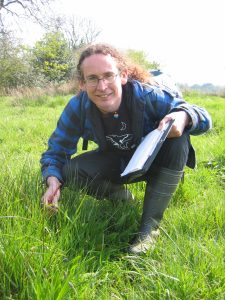
Gib Hill has small fields bounded by hedges of historic and biodiversity value. More than fifty species of mosses, some uncommon, are to be found in the LNR, many of them associated with these hedgerows. A double sided hedge, which traces the continuation of Bott House Lane towards the south side of Castercliffe Iron Age fort, is of historic and biodiversity significance. It bisects the reserve from top to bottom and along most of its length forms the present-day municipal boundary between Nelson and Colne. With more than the requisite number of tree and supporting flower species it does qualify as the priority habitat: a Hedgerow of Importance. All the hedgerows are well-used by native and migratory birds, attracting many hundreds of migrating thrushes in autumn, needing the food and shelter provided.
Some of the nature reserve is a Biological Heritage Site (BHS). BHS are identified for their biodiversity value of at least County significance. Lancashire BHS’s contains features of substantive nature conservation value and are considered core sites of particular importance for recovery of habitats and species. They have a fundamental role to play in meeting both the UK and Local Biodiversity Action Plan targets and actions. The BHS sites are crucial for informing the Local Habitat Map and the developing Lancashire Local Nature Recovery Strategy.
The fields have been surveyed by the Lancashire Wildlife Trust in 2005, 2010 and 2021, who identified a total of 177 different types of plant and tree species present. Included in these are the following qualifying species for the BHS status:
Geranium Sylvaticum (Woodland Cranesbill)
Geranium sylvaticum, the woodland cranesbill or woodland geranium, is a species of hardy flowering plant in the family Geraniaceae, native to Europe and northern Turkey. The Latin specific epithet sylvaticum means “of woodland”, referring to the plant’s native habitat, as does its common name “woodland cranesbill”.
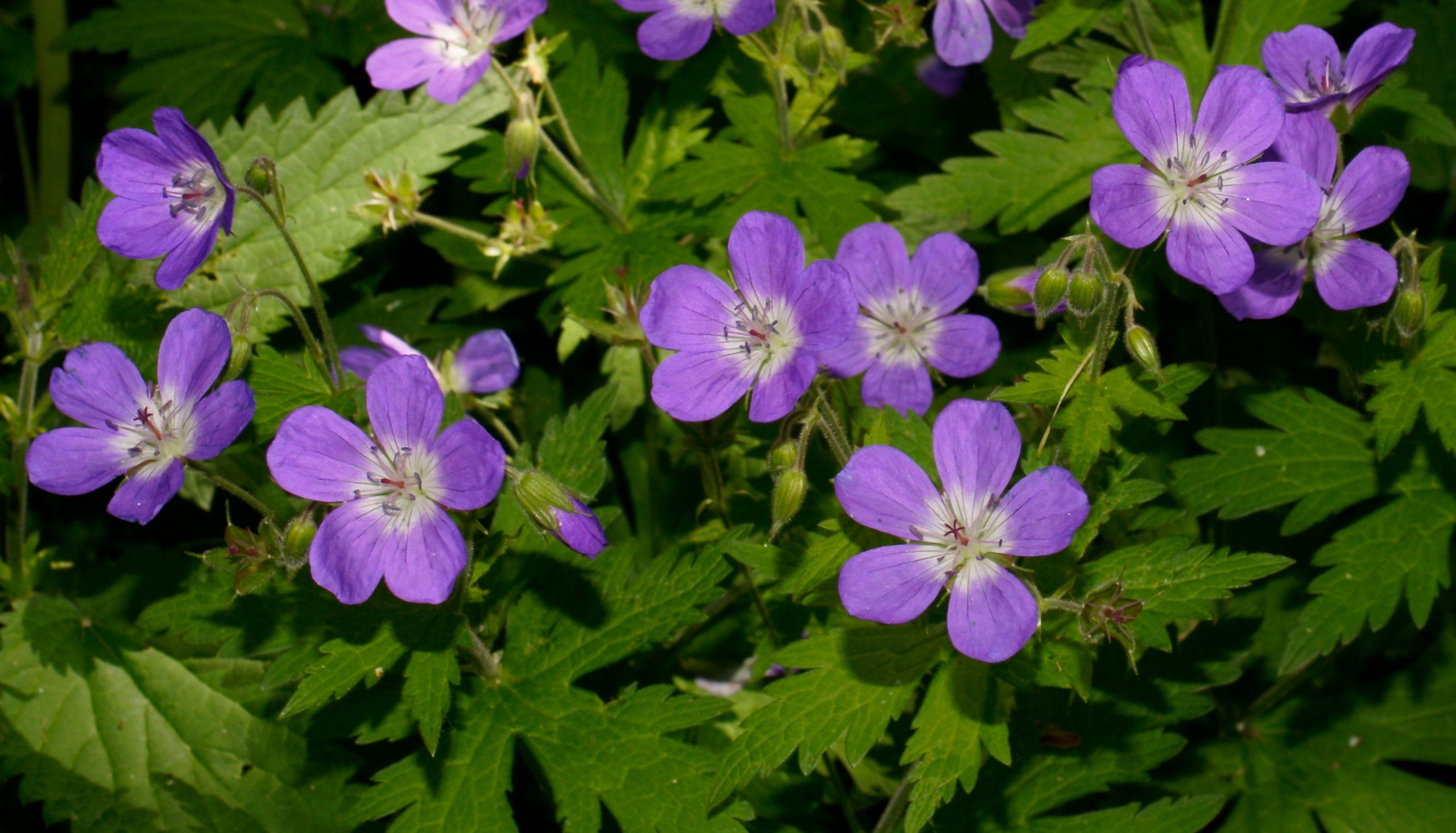 Photo attribution: Robert Flogaus-Faust, CC BY 4.0, via Wikimedia Commons
Photo attribution: Robert Flogaus-Faust, CC BY 4.0, via Wikimedia Commons
The plant grows to 75 cm (30 in) tall by 60 cm (24 in) wide, it is a mound-forming herbaceous, gynodioecious perennial with deeply cut and toothed 7-lobed basal leaves. In summer, flowers are borne on stalks with ruffs of leaves. The flower colour ranges from mauve to sky blue, depending on soil conditions. It has 10 stamens and glandular-hairy fruits.
Text taken from the Wikipedia article “Geranium sylvaticum”, which is released under the Creative Commons Attribution-Share-Alike License 4.0.
Lotus Pedunculatus (Greater Bird’s-foot-trefoil)
Lotus pedunculatus (formerly Lotus uliginosus), the big trefoil, greater bird’s-foot-trefoil or marsh bird’s-foot trefoil, is a member of the pea family (Fabaceae).

Photo attribution: Forest & Kim Starr, CC BY 3.0 US, via Wikimedia Commons
It is a herbaceous perennial growing throughout Europe in damp, open locations. As one common name suggests, it is a larger plant than related Lotus species, growing 20–80 cm (8–30 in) tall, with leaflets 10–25 mm (0.4–1 in) long and 10–20 mm (0.4–0.8 in) broad. Five to twelve golden-yellow flowers 10–18 mm (0.4–0.7 in) long are borne in an umbel at the tip of the upright stem.
Unlike related species, the stem is always hollow, and the sepals turn back at their tips. These sepal tips form a characteristic “green star” at the end of the flower bud. The peak flowering period in the United Kingdom is June and July.
Text taken from the Wikipedia article “Lotus pedunculatus”, which is released under the Creative Commons Attribution-Share-Alike License 4.0.
Silene Flos-cuculi (Ragged-Robin)
Silene flos-cuculi (syn. Lychnis flos-cuculi), commonly called ragged-robin, is a perennial herbaceous plant in the family Caryophyllaceae. It is native to Eurasia and has been introduced to North America.
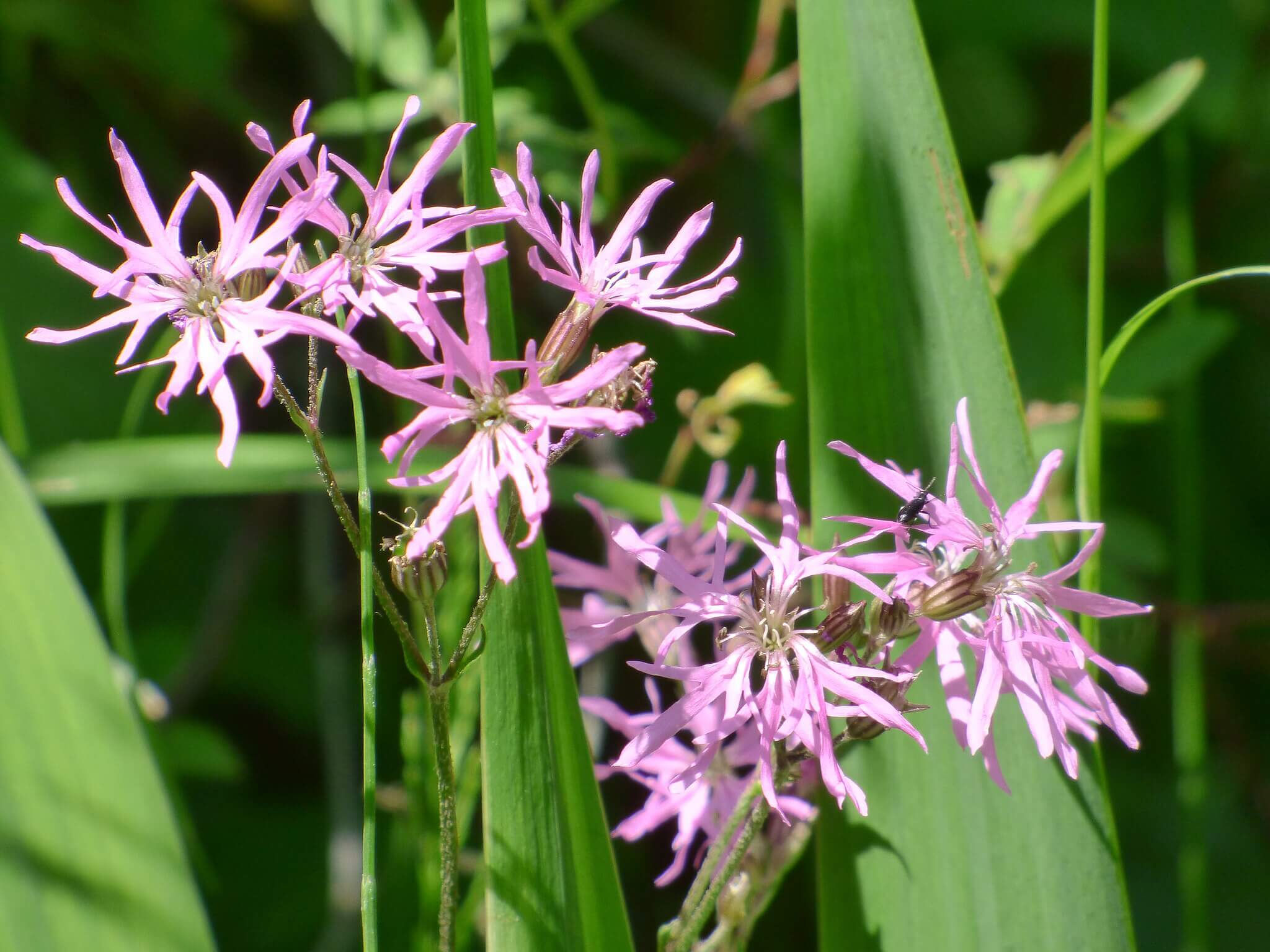 Photo attribution: Niepokój Zbigniew, CC BY-SA 4.0, via Wikimedia Commons
Photo attribution: Niepokój Zbigniew, CC BY-SA 4.0, via Wikimedia Commons
Silene flos-cuculi forms a rosette of low growing foliage with numerous stems 20 to 90 centimetres (8 to 35+1⁄2 inches) tall. The stems rise above the foliage and branch near the top of the stem. The leaves are paired, with the lower leaves spoon-shaped and stalked. The middle and upper leaves are linear-lanceolate with pointed apexes. All of the leaves are untoothed. The stems have barbed hairs pointing downward and these hairs make the plant rough to the touch.
Blooming from May to August (and occasionally later), the pink flowers are 3–4 cm wide. They have five narrow petals deeply divided into four lobes giving the flower an untidy, ragged appearance, hence its common name. The calyx tube is five-toothed with ten stamens.
The fruits consist of small (6–10 mm) capsules opening on top by five teeth and containing many small seeds; they are found on the plants from August onwards.
Text taken from the Wikipedia article “Silene flos-cuculi”, which is released under the Creative Commons Attribution-Share-Alike License 4.0.
Bistorta Officinalis (Common Bistort)
Bistorta officinalis (synonym Persicaria bistorta), known as bistort, common bistort, European bistort, or meadow bistort, is a species of flowering plant in the dock family Polygonaceae native to Europe and northern and western Asia. Other common names include snakeroot, snake-root, snakeweed, and Easter-ledges.
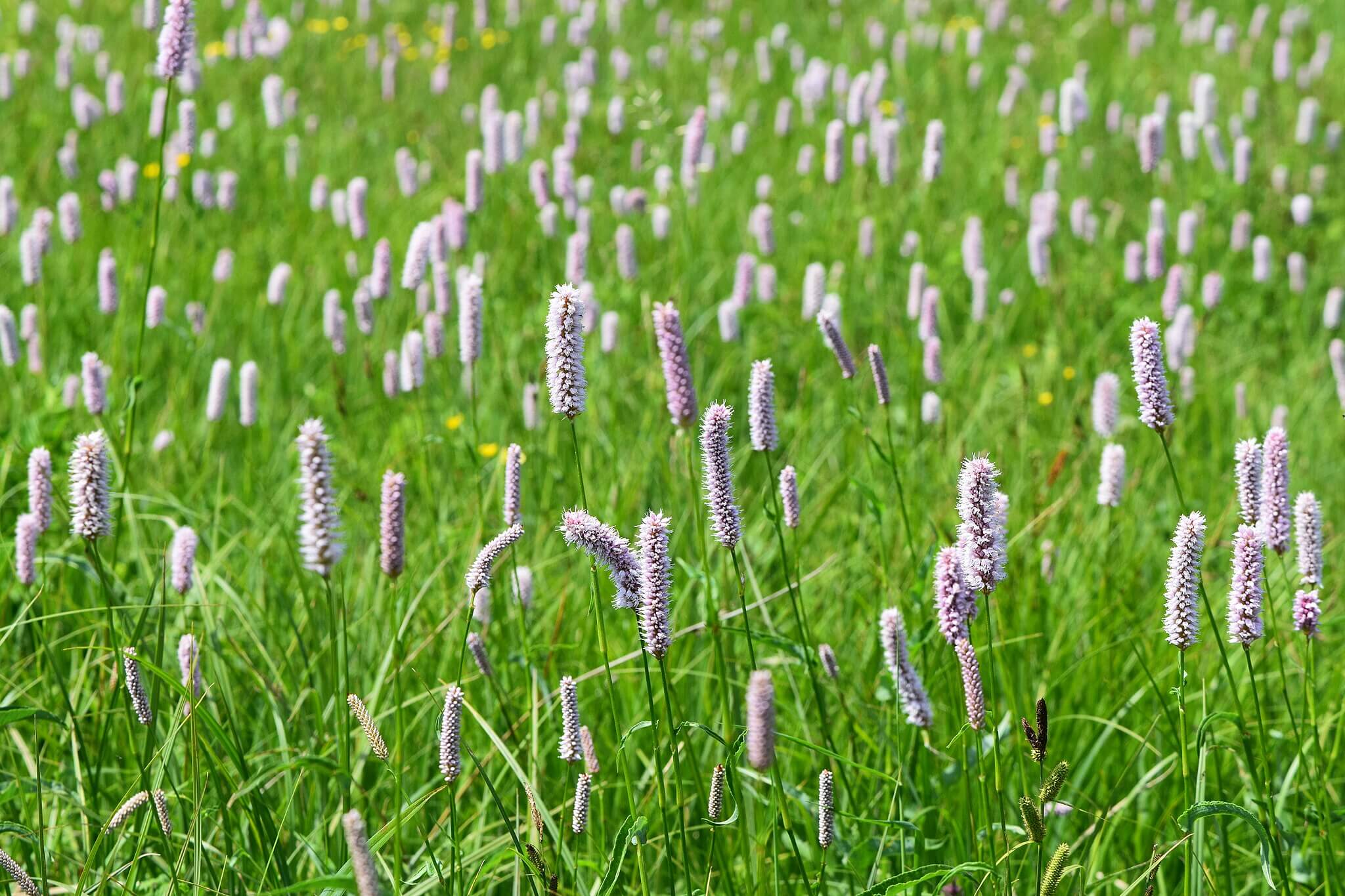
Photo attribution: Krzysztof Ziarnek, Kenraiz, CC BY-SA 4.0, via Wikimedia Commons
Bistorta officinalis is an herbaceous perennial growing to 20 to 80 centimetres (8 to 31 in) tall by 90 cm (35 in) wide. It has a thick, twisted rootstock which has probably given it its common name of snakeroot. The foliage is normally basal with a few smaller leaves produced near the lower end of the flowering stems. The leaves usually hairless; the basal ones are longish-oval with long winged stalks and rounded or heart-shaped bases; the upper ones are few and are triangular, tapered and stalkless. There are stipules at their base which are fused into a sheath surrounding the stem. The petioles are broadly winged. The inflorescence is a spike.
The plant blooms from late spring into autumn, producing tall, erect, unbranched, and hairless stems ending in single terminal racemes that are club-like spikes, 5–7 cm (2–3 in) long, of rose-pink flowers. The individual flowers are pink with five perianth segments, eight stamens, three fused carpels, and three free styles. The fruit is a glossy black nut. Flowering takes place in June and July. The plant grows in moist soils and under dry conditions goes dormant, losing its foliage until adequate moisture exists again.
Text taken from the Wikipedia article “Bistorta officinalis”, which is released under the Creative Commons Attribution-Share-Alike License 4.0.
Dactylorhiza Purpurella (Northern Marsh Orchid)
Dactylorhiza purpurella, the northern marsh orchid, is a perennial terrestrial orchid native to north-western Europe. It typically grows to a height of 10–15 cm, though it can occasionally reach 40 cm. The plant develops from tuberous roots that are finger-like (digitate) in form, long and tapering.
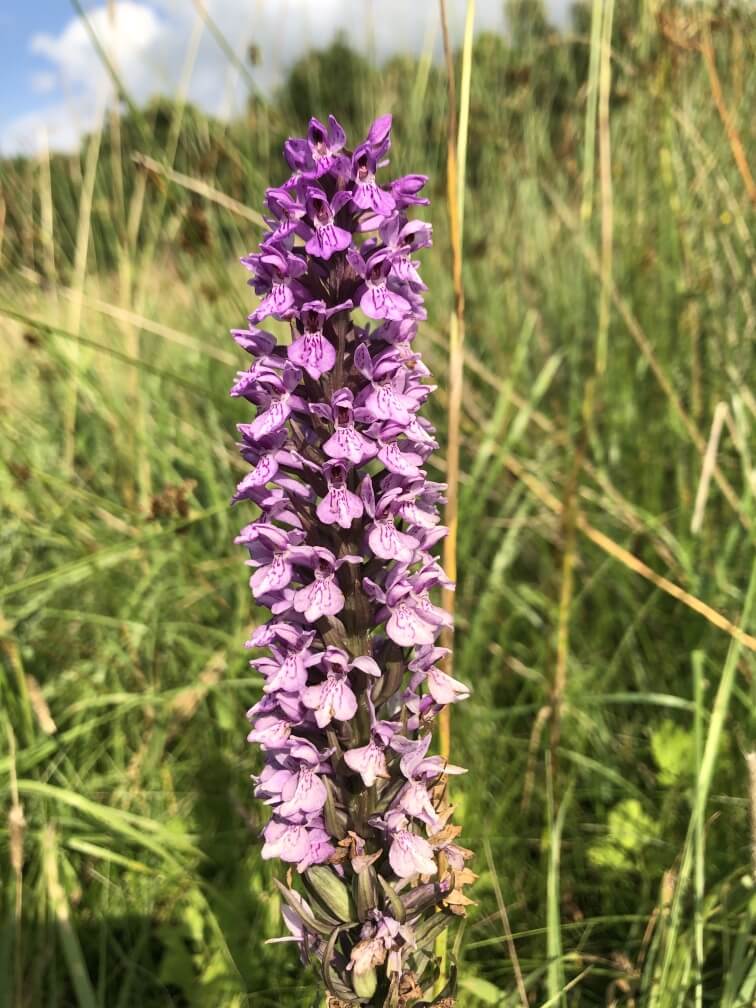
Photo attribution: Gib Hill Guardians
The plant remains dormant during winter, with leaves emerging in early spring. It produces 4–8 leaves that grow along the stem (cauline) but are often clustered toward the base. These leaves are keeled (folded along the midrib), lance-shaped (lanceolate), and taper to a fine point.
The inflorescence (flowering structure) is compact and relatively short (3–5 cm, occasionally up to 10 cm), with an ovoid to somewhat cylindrical shape that appears flattened at the top. It bears 10–30 flowers (occasionally up to 80) of bright purple or reddish-purple colouration. The lower bracts (modified leaves) that support the flowers are purplish and barely exceed the length of the flowers themselves.
Text taken from the Wikipedia article Dactylorhiza purpurella, which is released under the Creative Commons Attribution-Share-Alike License 4.0
Dactylorhiza Fuchsii (Common Spotted Orchid)
Dactylorhiza maculata subsp. fuchsii, the common spotted orchid, is a subspecies of flowering plant in the orchid family Orchidaceae.
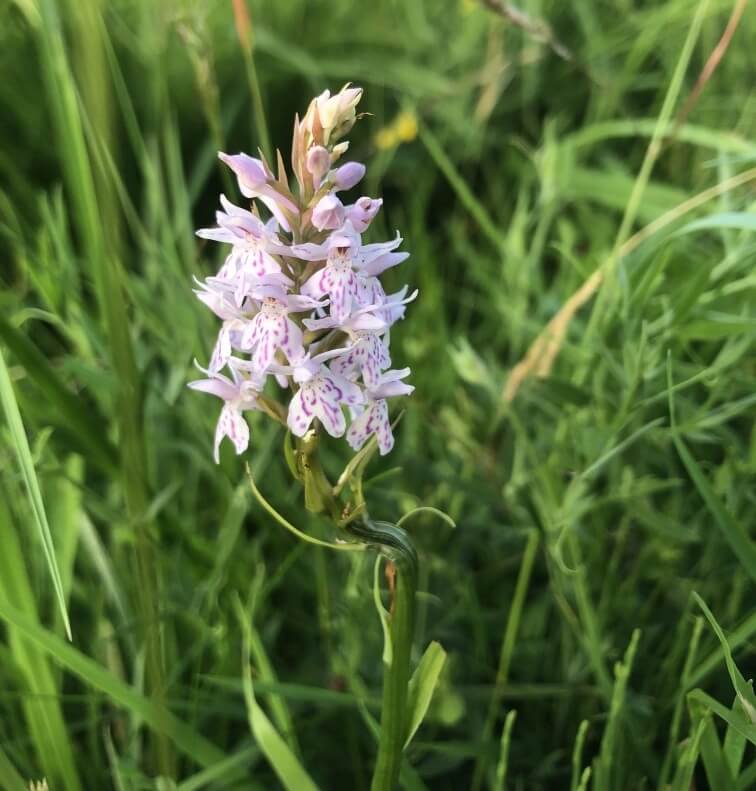
Photo attribution: Gib Hill Guardians
Dactylorhiza maculata subsp. fuchsii is a herbaceous perennial plant ranging from 10 to 60 centimetres (5 to 25 in) in height. The inflorescence is a dense-flowered spike, produced in June–August, that is at first conical then cylindrical. The flower colour can vary from white to pale purple with purple spots, a symmetrical pattern of dark purple loops or dots and dashes. The leaves are narrow lanceolate, keeled and often dark-spotted. Some colonies are highly perfumed, attractive to day-flying moths.
Text taken from the Wikipedia article Dactylorhiza maculata subsp. fuchsii which is released under the Creative Commons Attribution-Share-Alike License 4.0
Centaurea Nigra (Black Knapweed)
Centaurea nigra is a species of flowering plant in the family Asteraceae, and is also known as lesser knapweed, common knapweed, black knapweed and bell weed. It is native to central Europe, and has been introduced to temperate North America and Australasia, where it is usually regarded as a noxious weed due to its fast spread, hardiness and competitive potential.
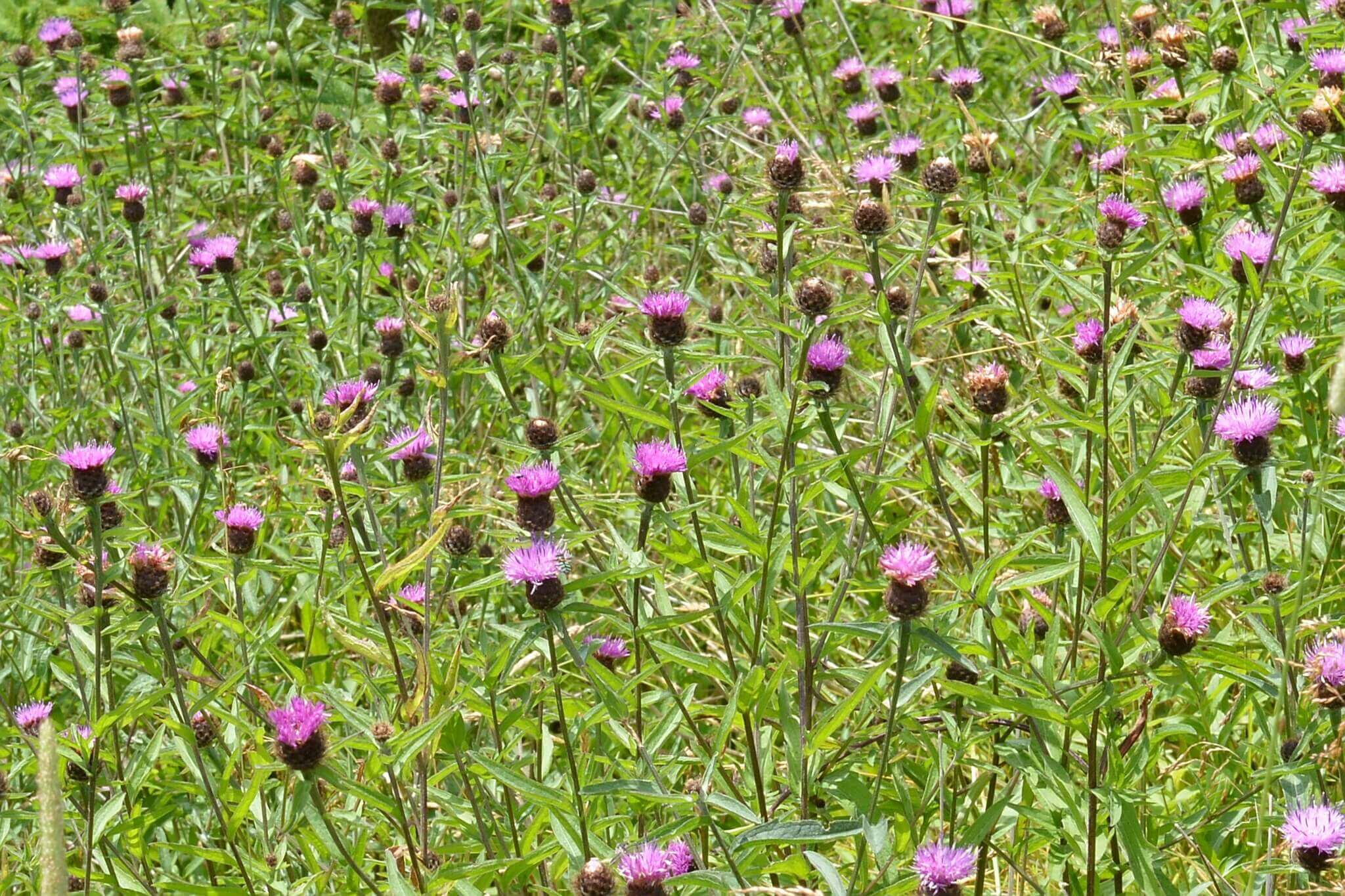
Photo attribution: Ryan Hodnett, CC BY-SA 4.0, via Wikimedia Commons
Centaurea nigra is an upright herbaceous perennial growing up to c. 1 m (3.3 ft) in height. It produces spreading rhizomes.
Centaurea nigra initially produces a basal rosette of leaves, which are usually entire and up to 30 cm long (11.8 in). Once the rosette is fully formed, it produces upright stems before eventually dying away. These upright stems turn purple when mature. The leaves on these stems are smaller, 1-8 mm x 2-10 mm, usually entire, grey-green and roughly hairy.
Centaurea nigra boasts high nectar and pollen production relative to other British perennial meadow flowers. Nectar, pollen and seeds are highly important food resources to many species of invertebrates and birds.
Text taken from the Wikipedia article Centaurea nigra which is released under the Creative Commons Attribution-Share-Alike License 4.0
Prunella Vulgaris (Selfheal)
Prunella vulgaris, the common self-heal, heal-all, woundwort, heart-of-the-earth, carpenter’s herb, brownwort or blue curls, is a herbaceous plant in the mint family Lamiaceae.
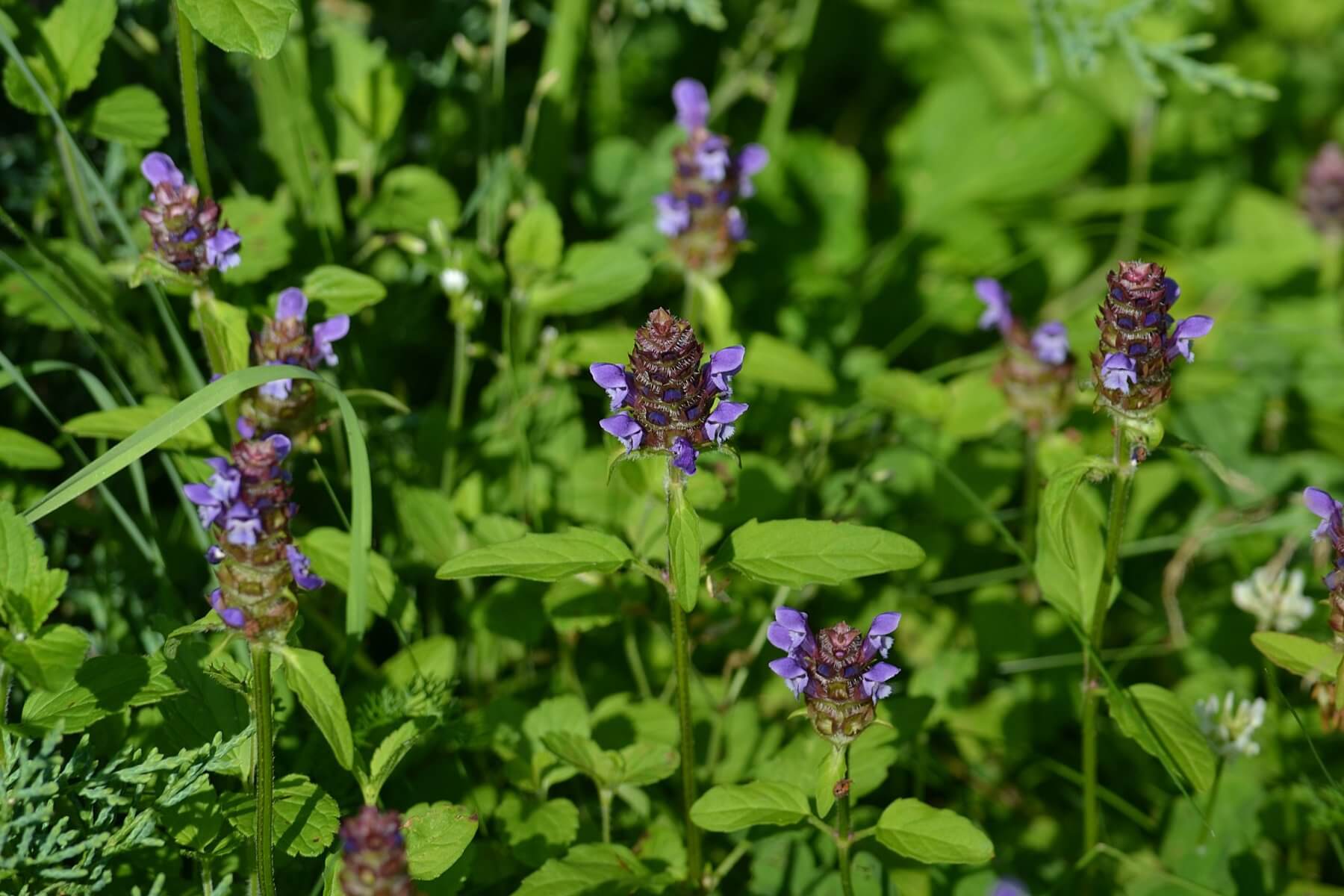
Photo attribution: Joanna Boisse, CC BY-SA 4.0, via Wikimedia Commons
Prunella vulgaris grows 5–30 cm (2.0–11.8 in) high, with creeping, self-rooting, tough, square, reddish stems branching at the leaf axes. The leaves are lance-shaped, serrated and reddish at the tip, about 2.5 cm (0.98 in) long and 1.5 cm (0.59 in) broad, and growing in opposite pairs down the square stem. Each leaf has 3-7 veins that shoot off the middle vein to the margin. The stalks of the leaves are generally short, but can be up to 5 cm (2.0 in) long.
Text taken from the Wikipedia article Prunella vulgaris which is released under the Creative Commons Attribution-Share-Alike License 4.0
Succisa Pratensis (Devil’s-bit Scabious)
Succisa pratensis, also known as devil’s-bit or devil’s-bit scabious, is a flowering plant in the honeysuckle family Caprifoliaceae.
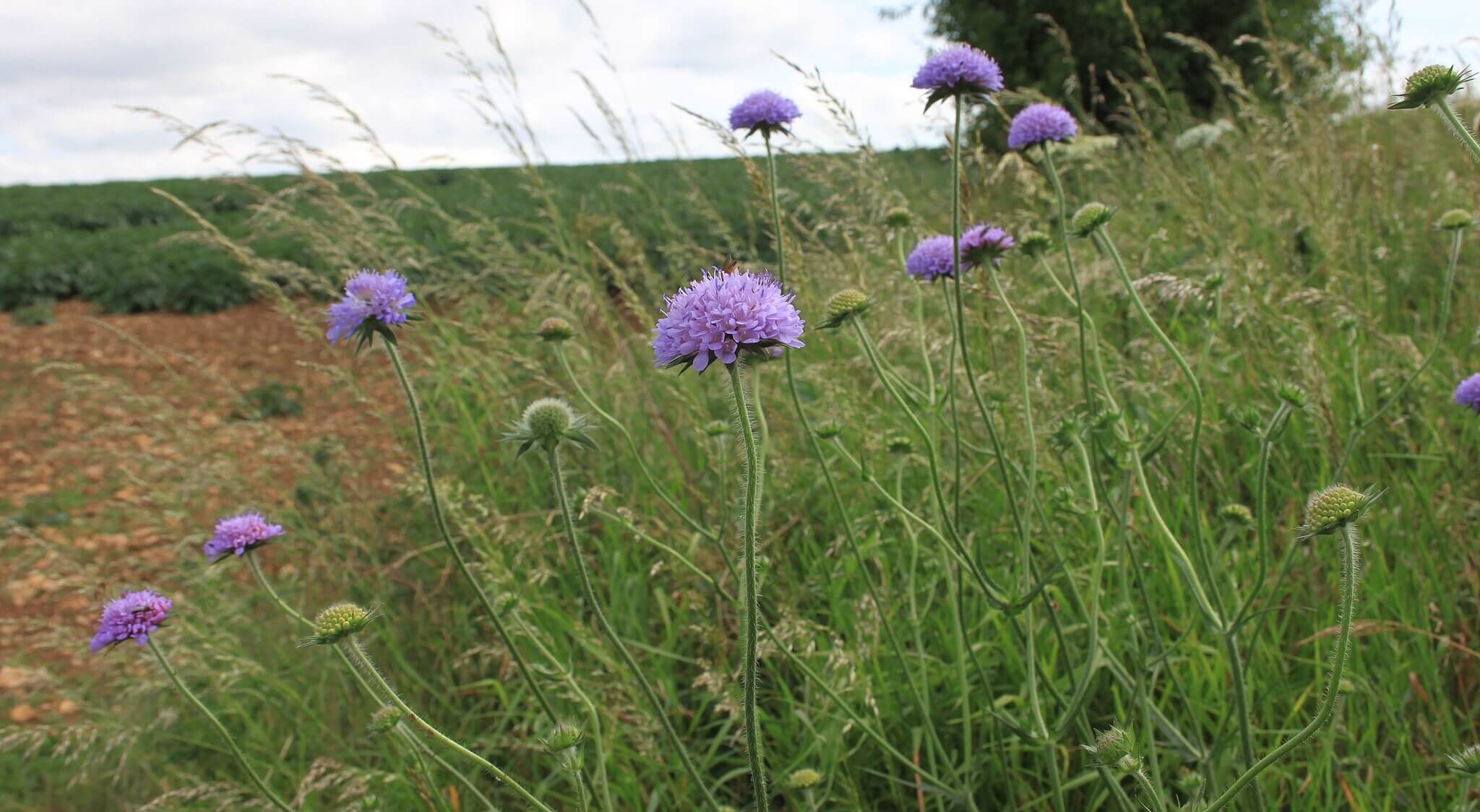
Photo attribution: Roger Davies, CC BY-SA 2.0, via Wikimedia Commons
Succisa pratensis is a herbaceous perennial up to 1m tall, growing from a basal rosette of simple or distantly-toothed, lanceolate leaves. The bluish to violet (occasionally pink) flowers are borne in tight compound flower heads or capitula. Individual flowers are tetramerous, with a four-lobed epicalyx and calyx and a four-lobed corolla. Male and female flowers are produced on different flower heads (gynodioecious), the female flower heads being smaller. The flowering period in the British Isles is from June until October.
It grows in wet or dry grassland and heath on acid or basic soils and is found in hedgerows, marshes, meadows and pastures.
Text taken from the Wikipedia article Succisa pratensis which is released under the Creative Commons Attribution-Share-Alike License 4.0
Hyacinthoides Non-scripta (Bluebell)
Hyacinthoides non-scripta (formerly Endymion non-scriptus or Scilla non-scripta) is a bulbous perennial plant found in Atlantic areas from the north-western part of the Iberian Peninsula to the British Isles, and also frequently used as a garden plant. It is known in English as the common bluebell or simply bluebell.
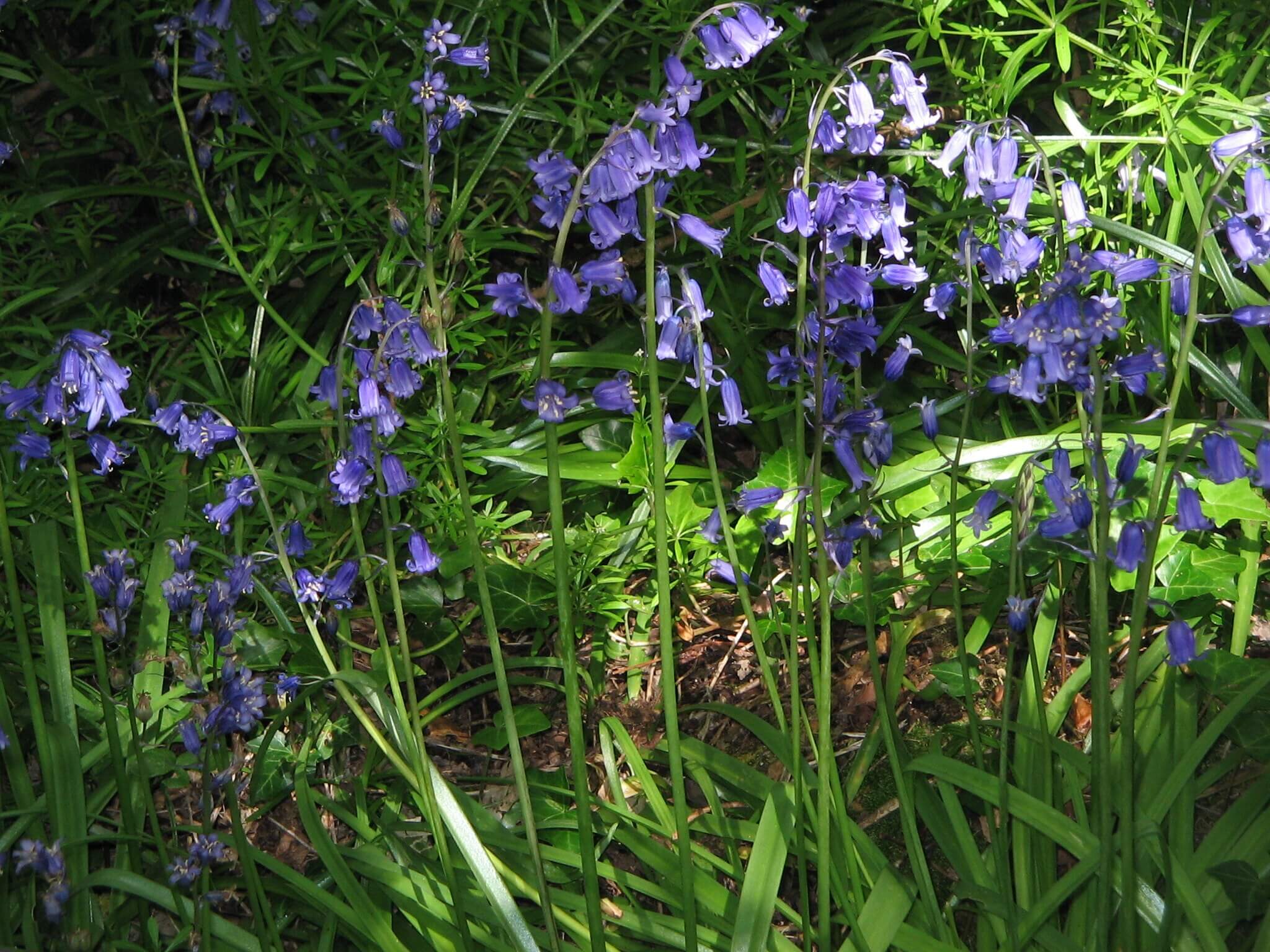
Photo attribution: Meneerke bloem, CC BY-SA 3.0, via Wikimedia Commons
In spring, H. non-scripta produces a nodding, one-sided inflorescence of 5–12 tubular, sweet-scented violet–blue flowers, with strongly recurved tepals, and 3–6 long, linear, basal leaves.
H. non-scripta is particularly associated with ancient woodland where it may dominate the understorey to produce carpets of violet–blue flowers in “bluebell woods”, but also occurs in more open habitats in western regions. It is protected under UK law, and in some other parts of its range.
Text taken from the Wikipedia article Hyacinthoides non-scripta which is released under the Creative Commons Attribution-Share-Alike License 4.0
Lotus Corniculatus (Common Bird’s-foot-trefoil)
Lotus corniculatus, also known as bird’s-foot trefoil is a flowering plant in the pea family Fabaceae. It has a wide distribution and is a favoured forage for livestock.
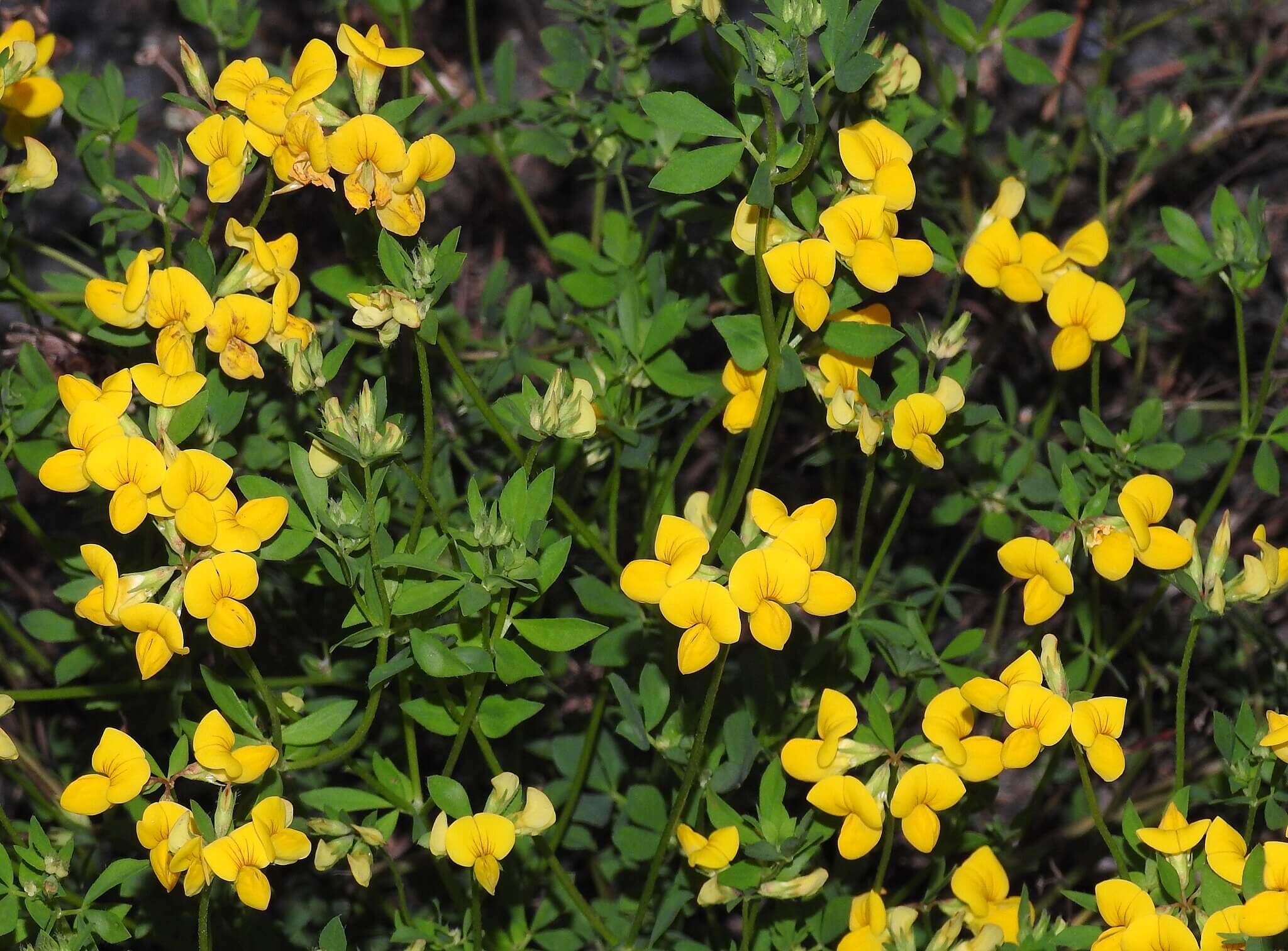
Photo attribution: Robert Flogaus-Faust, CC BY 4.0, via Wikimedia Commons
It is a perennial herbaceous plant. The height of the plant is variable, from 5 to 20 centimetres (2 to 8 inches), occasionally more where supported by other plants; the stems can reach up to 50 cm (20 in) long.
The name ‘bird’s foot’ refers to the appearance of the seed pods on their stalk. Five leaflets are present, but with the central three held conspicuously above the others, hence the use of the name ‘trefoil’.
The flowers bloom from June to September and develop into small pea-like pods or legumes.
Text taken from the Wikipedia article Lotus corniculatus which is released under the Creative Commons Attribution-Share-Alike License 4.0
Luzula campestris (Field Wood-rush)
Luzula campestris, commonly known as field wood-rush or Good Friday grass is a flowering plant in the rush family Juncaceae. It is also one of the plants known as chimney sweeps or sweep’s broom because of the brush-like appearance of their flowers. This is a very common plant throughout temperate Europe extending to the Caucasus.
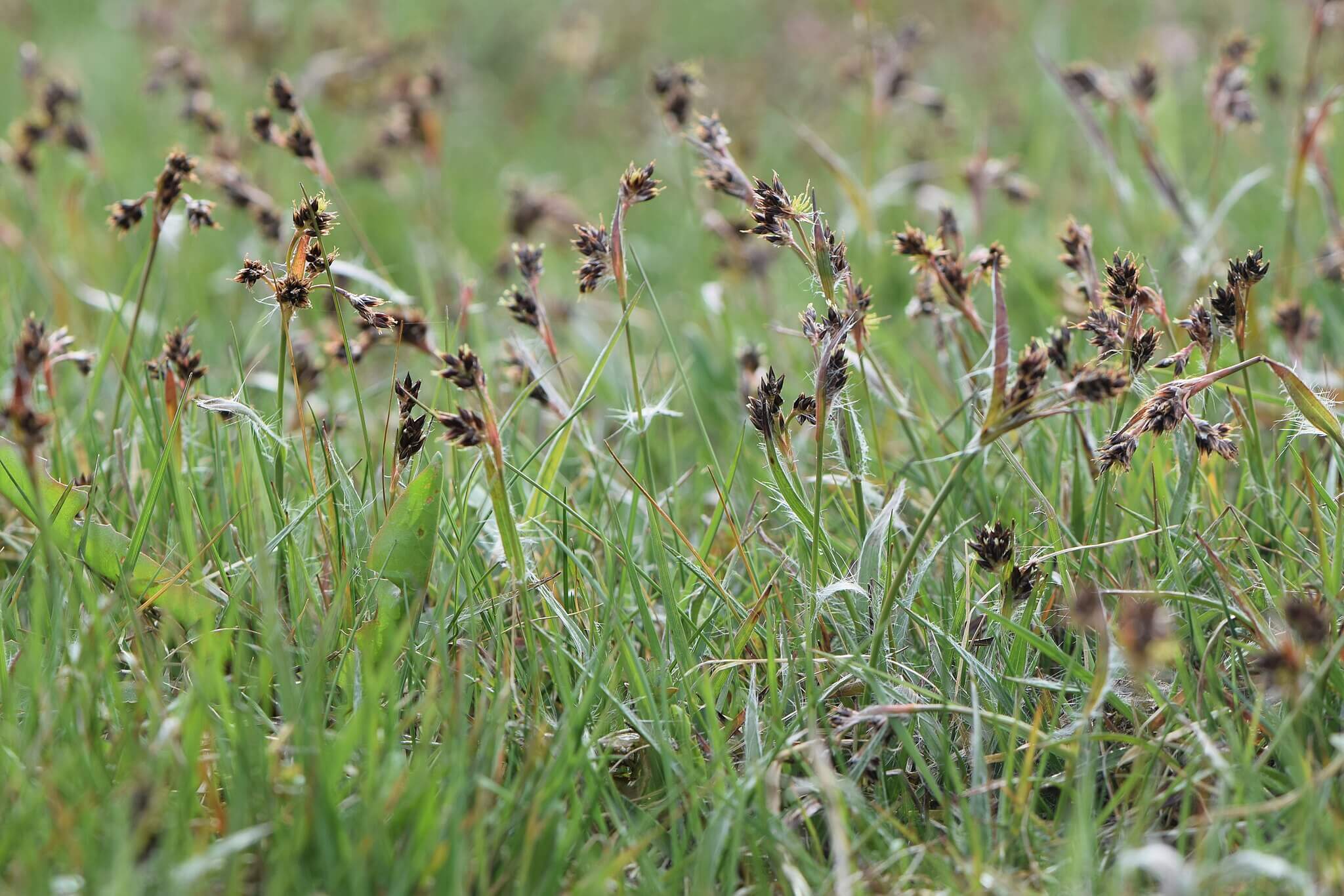
Photo attribution: Krzysztof Ziarnek, Kenraiz, CC BY-SA 4.0, via Wikimedia Commons
Luzula campestris is relatively short, between 5 and 15 cm (2 and 6 in) tall. It spreads via short stolons and also via seed produced in one stemless cluster of flowers together with three to six stemmed clusters of flowers. It is a perennial that flowers between March and June.
This species of Luzula is found on all types of native grasslands, and cultivated areas such as lawns, golf-course greens and fields.
Text taken from the Wikipedia article Luzula campestris which is released under the Creative Commons Attribution-Share-Alike License 4.0
Anemone Nemorosa
Anemone nemorosa (syn. Anemonoides nemorosa), the wood anemone, is an early-spring flowering plant in the buttercup family Ranunculaceae, native to Europe. Other common names include windflower, European thimbleweed, and smell fox, an allusion to the musky smell of the leaves.
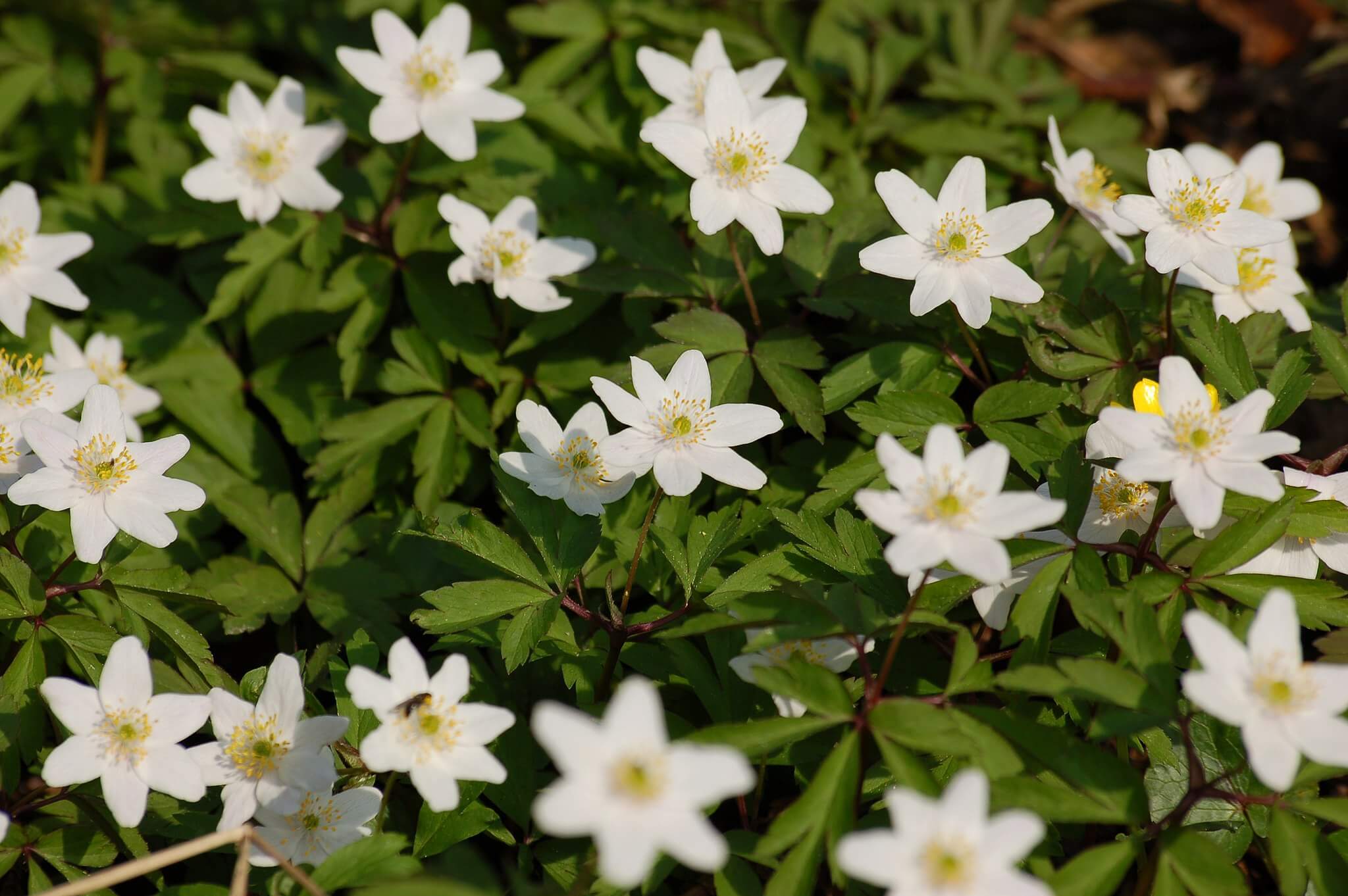
Photo attribution: Lilly M, CC BY-SA 3.0, via Wikimedia Commons
Anemone nemorosa is a rhizomatous herbaceous perennial plant less than 30 centimetres (12 in) in height. The compound basal leaves are palmate or ternate (divided into three lobes). They grow from underground root-like stems called rhizomes and die back down by mid summer (summer dormant).
The plants start blooming in spring, soon after the foliage emerges from the ground. The flowers are solitary, held above the foliage on short stems, with a whorl of three palmate or palmately-lobed leaflike bracts beneath. The flowers are 2 centimetres (0.8 in) diameter, with six or seven (and on rare occasions eight to ten) tepals (petal-like segments) with many stamens.
Text taken from the Wikipedia article Anemonoides nemorosa which is released under the Creative Commons Attribution-Share-Alike License 4.0
